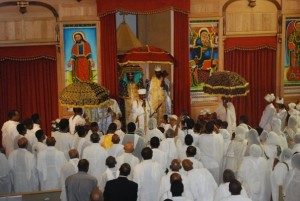
This entry is from guest blogger Tara Miller, frequent co-author on my books.
Over Thanksgiving weekend I visited an Ethiopian Orthodox Church. Sometimes it’s refreshing to go into a situation where everything is different so you don’t have preconceived ideas of “it has to be done this way” or “my old church did it that way.” Here you don’t expect anything to be the same. From that experience, I came away with some things that I think many of our American evangelical churches could learn from.
Use of the five senses in worship: One of the first things you notice in the Ethiopian Orthodox Church (as in many Orthodox Churches) is an opening up of the five senses to worship to the five senses immediately upon entry to the building. You hear drums and the chanting of the liturgy. You smell the incense from the sanctuary and the cooking spices drifting up from the fellowship hall. You see dozens of paintings representing scenes from the Bible that you can continue looking at throughout the service—everything you see means something. You can take off your shoes and feel the holy ground of the sanctuary. If you are Orthodox, you taste can taste the elements in communion. If you are not, you taste the homemade bread and tea and sometimes other spicy foods downstairs after the service. This multi-sensory experience of worship opens up communication of the gospel even to those who don’t understand the non-English words of the service. You can experience the gospel in the artistry, the music and the ritual.
Incorporation of children: Another thing you’ll quickly notice is the inclusion of children in every aspect of the service. They wander in and out of the sanctuary at will. A two-year-old picks up a small drum and joins in with the choir. A three-year-old naps in plain view on the steps leading up to the altar. During the sermon some children wander downstairs to kids’ classes during the sermon, but others stay in the service. Throughout, there is no shushing or getting kids out of the way. To compensate for the extra noise, they just turn up the sound system—none of the service is quiet.
A spirit of community support and gratitude: When people are part of a minority culture—particularly as immigrants—they band together out of necessity. Everyone knows one another and the sense of community support is palpable. One man needed to raise money for a medical treatment, and everyone gave. Thanksgiving was a foreign holiday to this church, but as one Ethiopian man told me, “We Ethiopians know what it is to be grateful.”
Challenge: Go visit a church that’s very different from your own. There will be many things you don’t like or wouldn’t work well in your culture group. But consider with an open mind: What you can you learn? What perspective can you gain?
